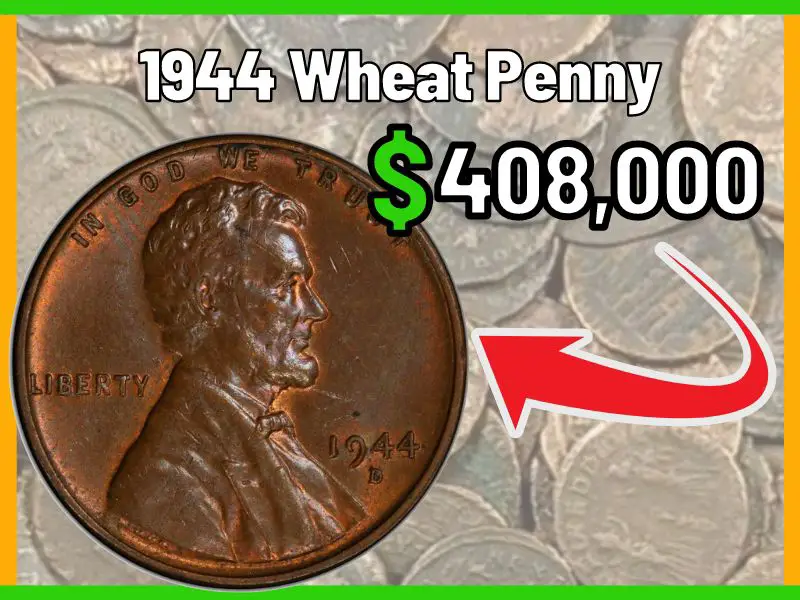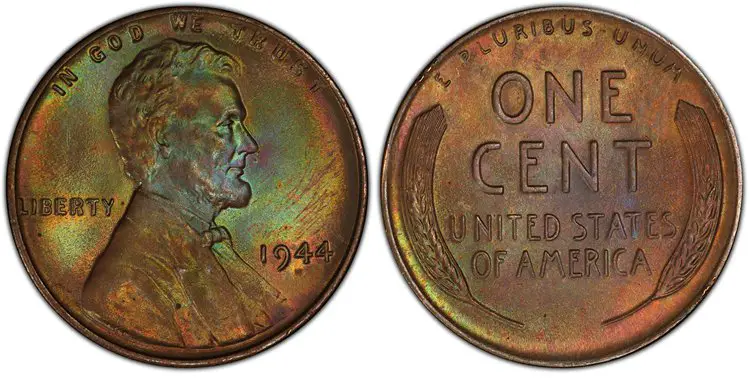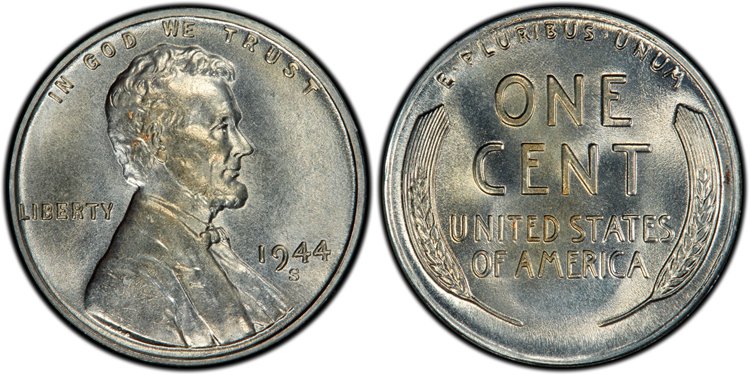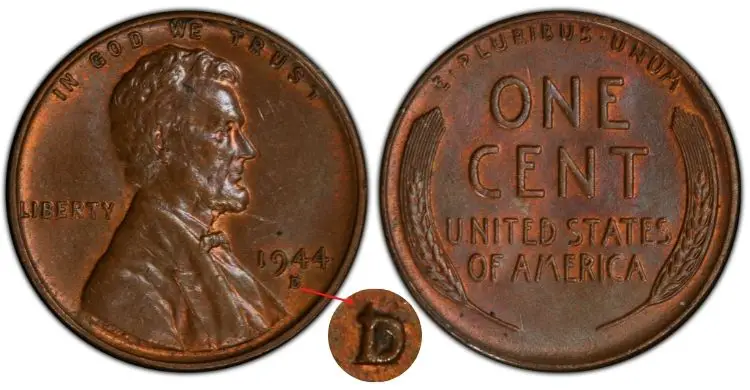
In general, however, all Lincoln pennies regardless of the mint mark are worth between $0.20 and $0.50 in circulated condition. Uncirculated coins are worth between $0.89 and $2.31, depending on the condition. A 1944 penny can be worth a small fortune if it’s a rare variety. For example, steel wheat pennies are extremely rare and can be worth from $10,000 to $500,000 depending on the condition. Similarly, 1944 D/S Wheat Cents error can be worth $481 to $752 or more.
1944 was a banner year in many respects. On the homefront, Americans were fully engaged in World War II, with millions of men and women serving in the armed forces and working in defense plants. On the international stage, 1944 saw a number of momentous events, including the D-Day invasion of Normandy and the liberation of Paris from Nazi occupation. In the end, 1944 was a year that would shape the course of history and change the world forever.
Do you have any coins from 1944? If so, how much are they worth? Most people would guess that a penny from that year is worth quite a bit, but it doesn’t have to be that way. In this blog post, we’ll take a look at the value of a 1944 Wheat Penny and help you determine whether it’s worth keeping or cashing in! So, without further ado, let’s get started!
A Brief History of 1944 Wheat Penny
First minted in 1909, the Wheat Penny was so named for its unique design which featured a stalk of wheat on the reverse side. For nearly a century, the Wheat Penny served as a staple of American currency. But by the 1960s, Rising production costs and declining demand led the US Mint to halt production of the coin. The last Wheat Penny was struck in 1958, bringing an end to a coin that had been in circulation for so long.
The Wheat Penny features a portrait of Abraham Lincoln on the front and two stalks of wheat on the reverse. The coin gets its name from the wheat stalks, which were included to symbolize the agricultural heritage of the United States. The designer of the wheat penny was Victor D. Brenner, a Lithuanian-born sculptor and engraver who moved to the United States in 1883. Brenner’s initial design for the coin was met with some criticism, but he eventually won over the U.S. Mint with his strong sense of patriotism and commitment to quality.
Some experts claim that in 1944, the United States began using shell casings to make Wheat cents. The move was necessitated by a shortage of copper, which was needed for the war effort. Initially, the new cents were made with a bronze alloy, but this was quickly changed to steel. The steel cents were then coated with zinc to give them a top layer of copper.
Though no longer in production, the Wheat Penny remains a popular collector’s item. Today, many examples of the coin can be found in circulation, providing a tangible link to America’s rich history. For collectors and historians alike, the Wheat Penny is truly a coin worth treasuring.
Are 1944 Wheat Pennies Rare?
1944 was a good year for wheat pennies. The Philadelphia Mint produced over 1.4 billion of them, while the Denver produced over 400 million and San Francisco Mint produced over 200 million. That’s a lot of wheat pennies! And because they have such an attractive year on them, many people have kept them as souvenirs.
1944 Wheat Pennies Quantity Minted |
||
| Year | Location | Minted |
| 1944 no mint mark | Philadelphia | 1,435,400,000 |
| 1944 Steel no mint mark | Philadelphia | 30 |
| 1944 D | Denver | 430,578,000 |
| 1944 D Steel | Denver | 7 |
| 1944 S | San Francisco | 282,760,000 |
| 1944 S Steel | San Francisco | 2 |
What Does a 1944 Penny Look Like?

Lincoln wheat pennies from 1944 were made from a copper-zinc alloy and has a smooth edge. This particular alloy is known as brass, and it has a distinctive yellow-gold color. Lincoln wheat pennies are also notable for their distinctive and popular design.
On the obverse, or front side, of the coin you’ll see President Abraham Lincoln. Above his head are the words “IN GOD WE TRUST.” On the left side of the coin is the word “LIBERTY” and on the right side is the date. The reverse, or back side, of the coin features wheat stalks. Above them are the words “E PLURIBUS UNUM” and below are “UNITED STATES OF AMERICA” and “ONE CENT.”
Another key identification element is the mint mark, which can be found on the obverse (front) of the coin under the date. Coins minted in Philadelphia will have no mint mark, while those from Denver will have a ‘D’ and those from San Francisco will have an ‘S’. The lack or presence of a mint mark can help to narrow down where the penny was minted.
With a little bit of investigation, it is relatively easy to identify a 1944 penny.
1994 Wheat Penny Rare Varieties
The 1994 Wheat Penny features several different varieties of errors that are considered to be quite rare. An error coin is a coin that has been struck improperly, resulting in a mistake that can be anything from a misprint to a misshapen coin. While some errors are relatively common, others are extremely rare, making them highly sought-after by collectors.
1944 Steel Wheat Penny

In 1944, the U.S. Mint switched from zinc-coated steel to copper for its one-cent coins in an effort to conserve copper for use in ammunition and other wartime necessities. However, a few steel planchets were inadvertently mixed in with the copper blanks and were struck into coins. The resulting 1944 steel cents are now among the most coveted error coins in existence. Only a handful are known to survive, and those that do are usually in poor condition. They are worth a significant amount of money for collectors.
These coins were struck at all three mints, but the vast majority were produced at the Philadelphia Mint. Today, an estimated 20 to 30 1944 steel cents are still in existence, with many in poor condition. The Denver and San Francisco Mints also produced steel wheat pennies in 1944, but far fewer survive today. In fact, only seven to ten 1944-D coins are known to exist, and just two 1944-S coins have been found.
1944 D/S Wheat Cents

In 1944, the Denver Mint produced a limited number of wheat cents with an error. The coins were struck from a die that had accidentally been imprinted with an S mintmark. The error was quickly discovered and corrected, but not before a few of the coins made their way into the hands of collectors. Today, these rare coins are highly prized by numismatists and can fetch a high price at auction.
While it is not clear how the error occurred, it is believed that the die was mistakenly sent to Denver from the San Francisco Mint. Whatever the cause, the 1944 D/S wheat cent is a fascinating example of an accidental error that has resulted in a valuable collectible.
How Much Is a 1944 Wheat Penny Worth?
| 1944 wheat penny value chart | ||
| Type | Circulated value | Uncirculated value |
| 1944 no mint mark | $0.20-$0.50 | $0.89 |
| 1944 D | $0.20-$0.50 | $1.14 |
| 1944 S | $0.20-$0.50 | $2.31 |
The value of a wheat penny depends on its condition, mint mark and if it contains any errors. That being said, all Lincoln pennies regardless of the mint mark are worth between $0.20 and $0.50 in circulated condition.
Uncirculated coins are worth a bit more. An Uncirculated 1944 penny with no mint mark is worth $0.89. An Uncirculated 1944 D penny is worth $1.14. And an Uncirculated 1944 S penny is worth $2.31.
That being said, a 1944 wheat penny can be worth a small fortune if it’s a rare variety. For example, steel wheat pennies are extremely rare and can be worth from $10,000 to $500,000 depending on the condition. Similarly, 1944 D/S Wheat Cents error can be worth $481 to $752 or more.
What is the Most Expensive 1944 Penny Ever Sold?
In 2021, a 1944 S Zinc-Coated Steel Lincoln Cent graded MS 66 by Professional Coin Grading Service (PCGS) sold at a Heritage Auctions sale for $408,000, setting a new world record price for the highest graded steel cent from this year. It is believed to be one of the few steel cents that were struck on zinc-coated steel planchets at the San Francisco Mint in 1944.
This beat the earlier world record for the same coin in the same condition which sold for $373,750. If you’re lucky enough to have a 1944 steel penny in your collection, be sure to have it professionally graded to see if it could be worth a small fortune!
How Do I Know if My 1944 Wheat Penny Is Worth Anything?
If you have a 1944 wheat penny, you might be wondering if it’s worth anything. The answer depends on a few factors, including the condition of the coin and whether it has any errors or special features. You can also learn a lot by comparing your coin to ones that have recently sold. For example:
- A circulated 1944 no mint mark wheat penny sold for $1.99.
- Uncirculated 1944 D wheat penny sold for $1.25.
- A circulated 1944 S wheat penny sold for $1.58.
- A circulated 1944 D over S error variety with visible wear sold for $100.
Final Thoughts
For many people, the 1944 wheat penny is a source of great fascination. These dime-sized coins are more than just a pretty face; they represent an important piece of American history. Minted in the midst of World War II, the 1944 wheat penny was introduced at a time when America was facing its greatest challenge. In spite of these difficulties, the United States mint was able to produce more than 2 billion 1944 wheat pennies.
Today, these coins are highly sought after by collectors and can be worth a small fortune. For example, steel wheat pennies are extremely rare and can be worth from $10,000 to $500,000 depending on the condition. Similarly, 1944 D/S Wheat Cents error can be worth $481 to $752 or more. Whether you’re a seasoned collector or a casual admirer, the 1944 wheat penny is sure to spark your interest.
FAQ
Are There Any 1944 Silver Pennies?
People sometimes refer to steel cents as “silver pennies,” but this is not accurate. While it is true that steel cents are silver in color, they are not made of silver. So, no, there are no 1944 silver pennies known in existence.
How Do I Know if My 1944 Steel Penny Is Real?
There are a few ways to tell if a 1944 steel penny is real. First, check to see if it sticks to a magnet. If it does, then it’s not a real 1944 steel penny because those were made of copper. Second, take a look at the surface of the coin. If it’s smooth and glossy, it’s probably a fake. Real 1944 steel pennies have a rougher surface due to the minting process. Finally, check the coin’s edge. If it’s perfectly round and uniform, odds are it’s not a genuine 1944 steel penny.
Why is the 1944 steel penny so valuable?
In 1944, the U.S. Mint made a mistake. They produced a small number of steel pennies instead of the usual copper coins. These steel pennies are now some of the most valuable error coins in existence. Only a handful of these coins are known to exist, and they are highly prized by collectors. The 1944 steel penny is a rare and interesting coin that is sure to continue to be popular with collectors for years to come.
